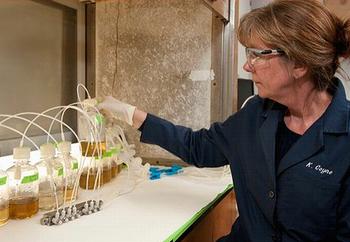
NEWARK, Delaware, July 2, 2013 (ENS) – A species of swimming marine algae that forms toxic algal blooms in the natural environment can be harnessed to grow a feedstock for bioethanol to fuel vehicles.
The algae Heterosigma akashiwo are uniquely suited for this task because they can live and thrive in an atmosphere high in nitric oxide, a component of the flue gases emitted by fossil-fueled power plants, scientists at the University of Delaware have demonstrated.
“The algae thrive on the gas,” said Kathryn Coyne, associate professor of marine biosciences in the university’s College of Earth, Ocean, and Environment. “They grow twice as fast and the cells are much larger in size compared to when growing without gas treatment.”

In fact, the microscopic cells grow rapidly on a gas mixture that has the same carbon dioxide and nitric oxide content as flue gas. As the algae grow they make large amounts of carbohydrates, which can be converted into bioethanol.
Coyne and her team have found a large increase in carbohydrates when the algae grow on flue gas as compared to air.
Heterosigma akashiwo is naturally found worldwide, says Coyne, an expert in algal blooms.
She discovered that the species may have a special ability to neutralize nitric oxide, a harmful gas that poses threats to environmental and human health.
The U.S. Agency for Toxic Substances describes nitric oxide as a sharp sweet-smelling gas at room temperature that is nonflammable but is one of the “most toxicologically significant nitrogen oxides.”
Nitrogen oxides are released to the air from the exhaust of motor vehicles, the burning of coal, oil, or natural gas, and during processes such as arc welding, electroplating, engraving, and dynamite blasting.
Low levels of nitrogen oxides in the air can irritate the eyes, nose, throat, and lungs. Breathing high levels of nitrogen oxides can be fatal.
The characteristic ability of this algae to neutralize nitric oxide and grow on a gas containing it prompted Coyne and her team to investigate whether it could grow on carbon dioxide without getting killed off by the high nitric oxide content in power plants’ flue gas.
This problem has foiled similar attempts by other scientists using different types of algae.
For a year in a lab at the University of Delaware, Coyne and her collaborator, Jennifer Stewart showed that Heterosigma akashiwo not only tolerates flue gas, but flourishes in its presence.
The algae need no other nitrogen sources beyond the nitric oxide in flue gas to grow, a cost-saving method of raising Heterosigma akashiwo for biofuel production.
“This alone could save up to 45 percent of the required energy input to grow algae for biofuels,” Coyne said.
Funded by the Delaware Sea Grant College Program, will investigate ways of enhancing the growth of Heterosigma akashiwo.
The researchers are exploring opportunities for partnerships with companies to scale up the growth process and more closely examine Heterosigma akashiwo as a biofuel producer.
Development of their technology could support a national focus on carbon pollution reduction that would complement President Barack Obama’s major speech last week on climate change, Coyne said.
“Our approach to the issue is to not just produce biofuels,” she said, “but to also use this species for bioremediation of industrial flue gas to reduce harmful effects even further.”
Copyright Environment News Service (ENS) 2013. All rights reserved.
